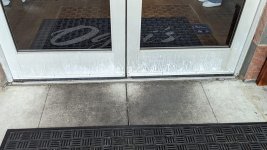How Sodium Hydroxide Affects Metal Door Frames
Providing Tips for Safe & Effective Use
 Sodium hydroxide. Commonly aka Caustic Soda.
Sodium hydroxide. Commonly aka Caustic Soda.Is a powerful cleaning agent frequently used in pressure washing. While it can effectively remove stubborn grime
and grease, its interaction with metal surfaces, particularly door frames, requires careful consideration.
and grease, its interaction with metal surfaces, particularly door frames, requires careful consideration.
Understanding Sodium Hydroxide
Sodium hydroxide (NaOH) is a highly caustic chemical known for its ability to break down organic materials. It's a common ingredient in many industrial cleaning products due to its effectiveness in cutting through heavy grease, oils, and organic build-up. However, its caustic nature also means it can react aggressively with certain materials, including metals.Reaction with Metal Door Frames
When sodium hydroxide comes into contact with metal, particularly aluminum and other soft metals. iIt can cause a chemical reaction that leads to corrosion. This reaction occurs because sodium hydroxide is a strong base. Although it can break down the protective oxide layer on metal surfaces, leading to pitting & damage. Step-By-Step Example of What Can Happen
- Initial Contact: When sodium hydroxide solution is applied to a metal door frame, it begins to react with the surface.
- Oxide Layer Breakdown: The caustic soda starts breaking down the oxide layer that naturally forms on metals like aluminum.
- Corrosion and Pitting: As the protective layer is compromised. The underlying metal is exposed to further chemical reactions, leading to corrosion & pitting.
- Surface Damage: Over time, repeated exposure can lead to significant surface damage. As well as weakening the structural integrity of the door frame.
Preventing Damage
Consider the Following Tips To Prevent Damage
When Pressure Washing With Sodium Hydroxide
When Pressure Washing With Sodium Hydroxide
- Dilution: Always dilute sodium hydroxide to the recommended concentration to reduce its caustic strength.
- Pre-Treatment Testing: Test a small, inconspicuous area before full application to assess the reaction.
- Protective Coating: Apply a protective coating or use a less reactive cleaner for sensitive metal surfaces.
- Rinse Thoroughly: After cleaning, rinse the metal surfaces thoroughly with water to neutralize the sodium hydroxide.
Alternative Cleaning Solutions
For metal door frames, consider using less aggressive cleaning agents that are specifically designed for metal surfaces. Products with neutral pH or those containing mild detergents can effectively clean without causing damage.While Sodium Hydroxide is a Powerful Cleaning Agent
It requires caution to prevent corrosion and damage. When used on metal door frames.
By understanding its chemical properties and taking preventive measures, you can ensure effective
and safe cleaning. Always test on a small area, dilute appropriately, and rinse thoroughly to maintain
the integrity of metal surfaces.
It requires caution to prevent corrosion and damage. When used on metal door frames.
By understanding its chemical properties and taking preventive measures, you can ensure effective
and safe cleaning. Always test on a small area, dilute appropriately, and rinse thoroughly to maintain
the integrity of metal surfaces.

